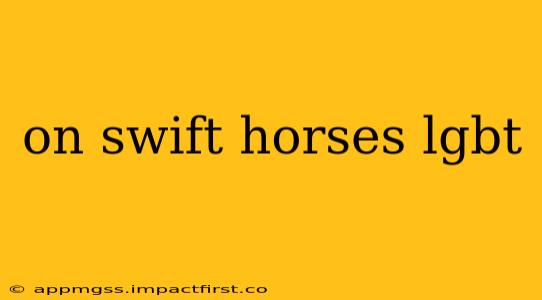The Western genre, often stereotyped as a hyper-masculine space dominated by heterosexual cowboys, has a surprisingly rich, albeit often overlooked, history of LGBTQ+ representation. While overt portrayals were largely absent for much of the genre's history due to societal norms and censorship, subtle cues, coded language, and interpretations reveal a fascinating undercurrent of queer narratives in both literature and film. This exploration delves into how LGBTQ+ themes have been subtly woven into the fabric of the Western, highlighting both the challenges and the evolving nature of representation within this iconic genre.
What are some examples of LGBTQ+ themes in Westerns?
This question lies at the heart of understanding the genre's complexities. Direct representations are rare in the classic era of Westerns, often constrained by the Hays Code and societal expectations. However, many scholars and viewers have interpreted certain relationships and character dynamics through a queer lens. For instance, close bonds between male characters, often portrayed as unwavering loyalty, can be reinterpreted as unspoken romantic or affectionate relationships. The emphasis on freedom and escape in the Western landscape can also be seen as a metaphor for the liberation sought by LGBTQ+ individuals. Examining the unspoken, the subtext, and the coded language becomes crucial in uncovering these hidden narratives.
How has LGBTQ+ representation in Westerns changed over time?
Modern Westerns offer a more explicit and diverse representation of LGBTQ+ characters. As societal attitudes have evolved, filmmakers and writers have felt more comfortable exploring queer themes directly. This includes featuring characters who openly identify as LGBTQ+, engaging in same-sex relationships, and navigating issues specific to their identities within the context of the Western setting. This shift reflects a broader societal movement towards greater inclusivity and a recognition that the Western genre, like any other, can and should reflect the diversity of human experience.
Are there any modern Westerns with prominent LGBTQ+ characters?
While the classic Westerns largely lacked explicit queer representation, recent films and television shows have begun to tackle this omission. These newer works often use the Western setting as a backdrop to explore the complexities of LGBTQ+ life, using the themes of isolation, community, and resilience in unique and meaningful ways. These productions represent a significant step towards greater inclusivity and a more nuanced understanding of the genre. Note that while specific titles would require a separate detailed article to avoid potential inaccuracies and to properly credit the work of filmmakers and writers, the growing presence of LGBTQ+ themes is undeniably evident in modern interpretations of the Western.
What are the challenges of portraying LGBTQ+ characters authentically in Westerns?
The challenge lies in avoiding both tokenism and stereotypes. Authentic representation demands crafting characters who are complex, multifaceted, and whose sexual orientation or gender identity isn't simply a plot device but an integral part of their identity and experience. This necessitates careful consideration of historical context, nuanced storytelling, and a commitment to avoiding harmful tropes or generalizations. The goal should always be creating characters that resonate as real people, with their own individual stories to tell, within the unique context of the Western genre.
What are some of the potential interpretations of "coded" language in classic Westerns?
The use of coded language in classic Westerns is a subject of ongoing scholarly debate. Often, seemingly platonic relationships between male characters, characterized by intense loyalty and physical affection (such as sharing a blanket or sleeping in close proximity), can be reinterpreted through a queer lens. These interpretations challenge traditional readings and suggest a deeper complexity in the relationships portrayed. Such interpretations should, however, be approached with sensitivity and a deep understanding of historical context, avoiding anachronistic applications of modern perspectives.
In conclusion, the journey of LGBTQ+ representation in Westerns mirrors the broader societal shifts regarding LGBTQ+ inclusion. While the past largely lacked overt representation, modern interpretations are increasingly embracing diversity and authenticity, challenging conventional narratives and expanding the boundaries of this iconic genre. The conversation continues, prompting critical analysis and pushing for more inclusive and representative storytelling in the future.
